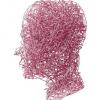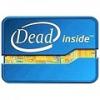
A greatly overlooked factor for cognition/clarity: Kynurenic Acid (Glycine/Sarcosine users, read)
#61
Posted 06 August 2016 - 04:40 AM
Sent from my SM-T810 using Tapatalk
#62
Posted 07 December 2017 - 06:55 PM
IMHO, the whole idea about supressing KYNA is misguided. if the premise of it was true, schizophrenics would have superpowers and we know they don't (or do they?).
LOL, stupid mistake. Schizo=high KYNA, ADHD=low KYNA. So, i really meant ADHD having superpowers. But actually they do. There is this paradoxal hyperattention phenomenon in ADHD. Maybe this is what the OP is after?
I think that makes sense.
Schizophrenics = high KYNA, high DOPA
ADHD = low KYNA, low DOPA
Autism = low KYNA, low DOPA (high ACh?)
Mutism = low-normal KYNA, low DOPA (high ACh?)
Here's an Organix-Depression profile of a mutist (me ![]() ) attached.
) attached.
And an anecdotal comment of a father of an autistic kid:
I came across this article , when I was hectically searching web for elevated quinolinic acid in urine. My 19 yr. old son who is suffering from autism was recently tested for urine OAT. His KYN acid is 0.0 , while QUIN acid is on higher side.On serum amino acid test, he is deficient of L-tryptophan and L-tyrosine is on higher side. The OAT also shows that HVA is on higher side while VMA is on lower side.To reduce his aggressive behaviour , we supplement nearly 1g L-tryptophan per day. Even though his violent behaviour gets reduced with L-tryptophan, he does not sleep adequately. His sleep reduces in proportion with L-tryptophan supplementation. To me it appears that elevated Quinolinic acid may be the reason behind disturbed sleep. If I stop L-tryptophan , his periodic violent behaviour ( once in a week) returns but then sleeps more than required. Supplemental vit B6 of 50 mg/day may not be adequate. Any suggestion from anybody ? Thanks
All what he says applies almost to my results also (KYNA is normal). Mutists are like autists but with a high EQ (emotional quotient) whereas autists have like zero EQ but higher IQ.
Attached Files
Edited by Caravaggio, 07 December 2017 - 06:57 PM.
#63
Posted 07 December 2017 - 10:29 PM
I think that makes sense.
Schizophrenics = high KYNA, high DOPA
ADHD = low KYNA, low DOPA
Autism = low KYNA, low DOPA (high ACh?)
Mutism = low-normal KYNA, low DOPA (high ACh?)
Generally, that makes sense with a little caveat: location matters. Schizophrenics have high dopamine in some pathways (causing positive symptoms) yet low in others (negative symptoms).
I'm not that familiar with mutism. isn't that a severe social anxiety?
BTW, i'm not sure I agree with the whole promise of this thread. The harmala alkaloid is mainly known for it's MAOi action: https://en.wikipedia...armala_alkaloid
this alone could be benefiting the OP.
Edited by jack black, 07 December 2017 - 10:30 PM.
#64
Posted 13 February 2018 - 04:10 AM
Interesting stuff.
Jerusalem balsam effective to inhibit KAT II. Comparable to Cerebrolysin and D-Cycloserine (in vitro)
https://www.omicsonl...y.php?aid=89870
LostFalco making me itchy to try galantamine and d-cyclo
#65
Posted 19 March 2018 - 01:56 AM
I have to say that this has been an extremely informative thread x2, now.
I read it a few months back in passing thinking it detailed mechanisms in an interesting way. Now, having a better definition on my own symptoms the relevance and insight is truly great. Highly actionable thread - my favorite kind.
Thanks!
#66
Posted 19 March 2018 - 06:21 AM
I've read somewhere that in deficit schizophrenia, a metabolite of l-tryptophan is causing neurotoxicity leading to death of neurons. In my case, deficit schizophrenia fits me the best. I have all negative symptoms without any positive and my brain scan showed atrophy. Maybe I will find that publication I've read... Is there an easy way to block the unwanted metabolite/s?...
#68
Posted 22 April 2018 - 02:25 PM
"The NMDA receptor is one of three types of ionotropic glutamate receptors, the others being the AMPA and kainate receptors." wiki
Sorry I was confused for a bit I thought NMDA was glutamate.
"Related amino acid derivatives: Sarcosine; Dimethylglycine; beta-Methylamine-L-alanine" wiki
I've been curious about Sarcosine and DMG (dimethylglycine) lately. I almost bought them. I bought Glycine instead just to see what's up.
Anyone read up on Ketogenic diet raising kynurenic acid levels?
or how about the spices and herbs below:
Very interesting find. My very basic understanding is that the holy trinity primarily responsible for higher thought is that of NMDA, AMPA and glutamate. Even if not, these are primary determinants of cognition and are modulated both directly and indirectly by first order nootropics. It seems to me then that this is an incredibly relevant avenue for further research.
As a buffer against excitotoxicity I wonder how far one could diminish KYRA before cell-death becomes problematic. As far as I know, stress is a major cause of excitotoxicity, but are there many other things that specifically cause it? It seems if you are chronically stressed then taking this would be a bad choice. However on the flipside, a seasoned meditator would perhaps gain much from this.
Do you take norharman extract or Syrian rue seeds themselves? Does the MAOI activity become noticeable at the doses you take? I may well look into this. Thanks again for your thorough investigations and clear exposition :-)
Although I think your donut topology comparison is a little off... Personally I don't walk around with my mouth glued to my anus :P
Does in only inhibit KYNA metabolites, and is it know whether they have any biological purpose?
#69
Posted 29 December 2018 - 12:10 AM
What was the amount of Syrian Rue grounded up that the OP was using? I don't know if he ever said - or anyone else for that matter know what a good daily microdose of this RIMA is ![]()
#70
Posted 30 December 2018 - 12:21 PM
No one has mentioned curcumin which I know is a cox-2 inhibitor which reduces KYNA. Curcumin also suppresses the induction of indoleamine 2,3-dioxygenase and IDO catalyzes the initial and rate-limiting step in the catabolism of tryptophan along the kynurenine pathway. It also protects against quinolinic stimulation of NMDA receptors, and I have read that in this means it has a balancing effect on the Kynurenine pathway, but I do not fully understand how and I can't find much more literature on this.
I also found this which lists some medications and natural products such as Resveratol, Epigallocatechin-3-gallate, Rosmarinic acid (rosemary extract), Genistein, Quercetin, Brassinin and Apigenin (4,5,7-trihydroxyflavone) that have anti-indoleamine 2,3-dioxygenase (IDO) activity. IDO inhibitors seem to modulate the Kynurenine pathway and are used as anti-cancer therapies as disrupted KP has been implicated in the progression of cancer too.
https://pdfs.semanti...886bc743cdf.pdf
"The enzymes that catalyze the first step of L-TRP catabolism are IDO-1, IDO-2 or TDO [14, 15]. These oxidatively cleave L-TRP to form N-formyl-L-kynurenine, which is hydrolyzed to the first stable metabolite of the KP, L-kynurenine (KYN).
https://www.ncbi.nlm...les/PMC5748880/
---
"A diverse range of small molecules have been developed as IDO-1 inhibitors, with most as anti-cancer agents [130, 131]. To date, three IDO inhibitors (Fig. 22) have reached clinical trials as cancer therapies: 1-methyl-D-tryptophan (1, 1-D-MT, Indoxomod, Newlink Genetics), imidazole NLG919 (2, Newlink Genetics) and hydroxylamidine INCM024360 (3, Epacadostat, Incyte) [132]."
"Several other IDO inhibitors have also been identified based on the scaffolds of β-carboline (e.g. norharman, 4, IC50 90 µM) [149, 150], phenylimidazole (e.g. 5-phenylimidazole, 5, IC5048 µM) [149, 151], quinone containing molecules including the natural products (exiguamine A, 9, Ki 41 nM); annulin B (12) [152-154] and brassinin (10, Ki 98 µM) [155], benzylisothiourea (7, IC50 2.2 µM) [156] and diaryl ketones (exemplified by 3-hydroxyphenyl(phenyl)methanone, 6, IC50 0.5 mM) [154]; structures shown in Fig. 33)."
https://www.ncbi.nlm...les/PMC5748880/
"Navoximod has several features of interest defined in preclinical studies. Its potency as an IDO1 inhibitor is EC50=75 nM in cell-based assays, with only 10- to 20-fold selectivity against TDO (92). Thus, navoximod may exhibit unique activity in tumors expressing both IDO1 and TDO, the latter of potential relevance to intrinsic or acquired resistance to IDO1 blockade (see below)."
"Its oral administration reduced plasma kynurenine levels by approximately 50% in mice and it relieved IDO1-induced T cell suppression in human cell cultures."
https://www.ncbi.nlm...les/PMC6021761/
---
"However, S-ESBA was not active towards KMO and KYNU and was shown to preferentially inhibit rat KAT-II over rat KAT-I with 97% and <5% inhibition at 1 mM respectively [187]. When infused by reverse dialysis in rat striatum S-ESBA significantly reduced extracellular KYNA by 32% after 1.5 hours. Increased dopamine was also observed, reaching a maximum of 265% of baseline level at 1.5 hours."
"Unlike S-ESBA, BFF-122 more potently inhibited human KAT-II, with an IC50in the low micromolar range and effectively reduced KYNA synthesis in rat brain [190]."
"Leading analogues from this series include ®-3-amino-7-bromo-1-hydroxy-3,4-dihydroquinolin-2(1H)-one with a reported IC50 of 10.5 nM and ®-3-amino-1-hydroxy-3,4-dihydroquinolin-2(1H)-one, known as PF-04859989 (30, Fig. 55) with an IC50 of 23 nM [194]. Importantly, PF-04859989 was shown to be more potent towards human KAT-II than rat KAT-II and could effectively cross the BBB. A single 10 mg/kg dose was shown to reduce brain KYNA by 50% [193] and restored nicotine induced glutamatergic activity in rat cortex [195]."
https://www.ncbi.nlm...les/PMC5748880/
I found PF-04859989 for sale here:
https://www.sigmaald...ng=en®ion=AU
I wonder what the right dosage is?
Edited by mono, 30 December 2018 - 01:21 PM.
#71
Posted 30 December 2018 - 01:27 PM
Also KMO inhibitors for increasing KYNA levels.
"As discussed above, the enzyme kynurenine-3-monooxygenase (KMO) is a well-rationalized therapeutic target for a range of neurodegenerative conditions, as KMO inhibition decreases concentrations of neurotoxic QUIN but increases neuroprotective KYNA. However, while some IDO inhibitors have reached clinical trials, KMO inhibitors are still at the pre-clinical phase of development."
https://www.ncbi.nlm...les/PMC5748880/
#72
Posted 31 December 2018 - 08:12 PM
#73
Posted 02 January 2019 - 05:01 PM
Also KMO inhibitors for increasing KYNA levels.
"As discussed above, the enzyme kynurenine-3-monooxygenase (KMO) is a well-rationalized therapeutic target for a range of neurodegenerative conditions, as KMO inhibition decreases concentrations of neurotoxic QUIN but increases neuroprotective KYNA. However, while some IDO inhibitors have reached clinical trials, KMO inhibitors are still at the pre-clinical phase of development."
Great find man this!
Look at this! :
4.2.2.2. PyrroloquinolinesPyrroloquinolines are a class of moderately active KMO inhibitors with IC50values ranging from 20-100 µM [177]. The most active of this series (7-Chloro-3-methyl-1H-pyrrolo [3,2-c]quinoline-4-carboxylic acid, 23, Fig. 44) showed selectivity towards KMO (IC50 24 µM in rat liver) in vitro compared to kynureninase (24% inhibition at 100 µM) and kynurenine aminotransferase (25% inhibition at 100 µM) [177].
Seems to indicate that PQQ boosts endogenous KYNA levels?
Also tagged with one or more of these keywords: kyna, sarcosine, glycine, b6 deficiency, schizophrenia, psychosis, symptoms, brain fog, nmda, ampa
8 user(s) are reading this topic
0 members, 8 guests, 0 anonymous users
























































